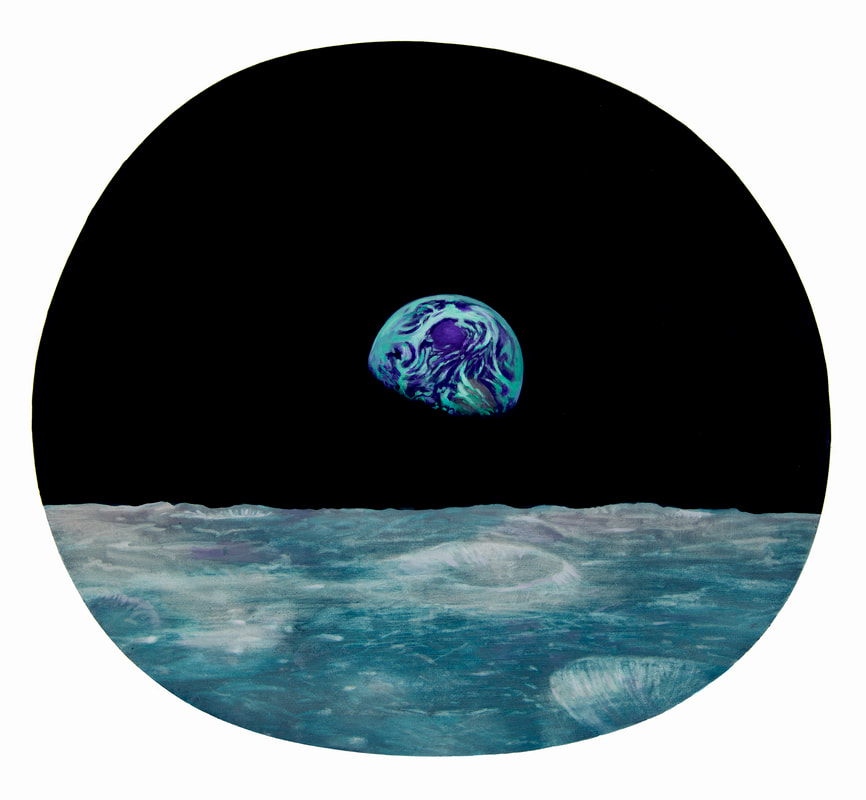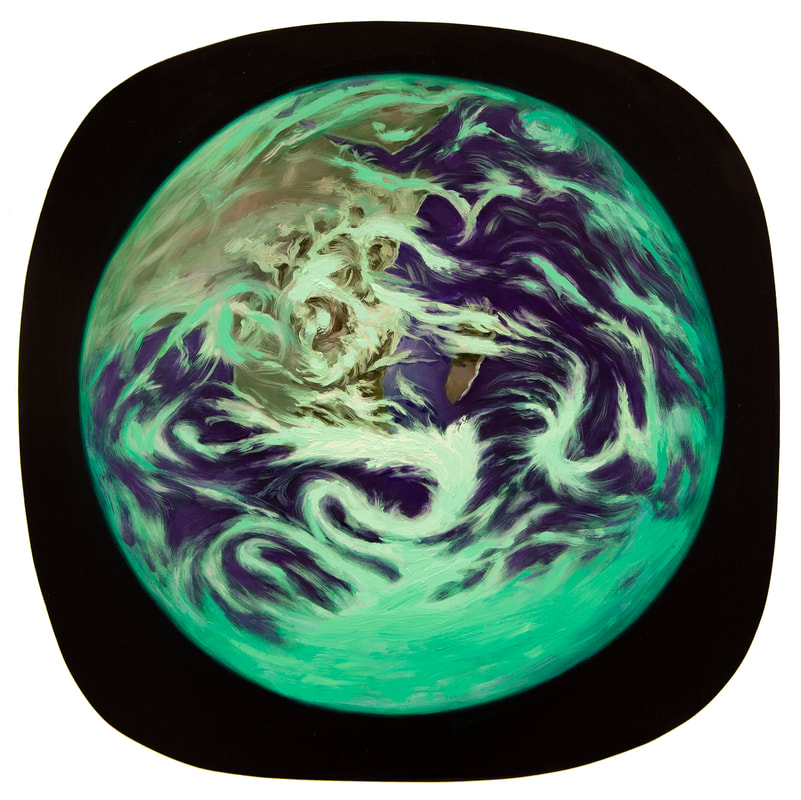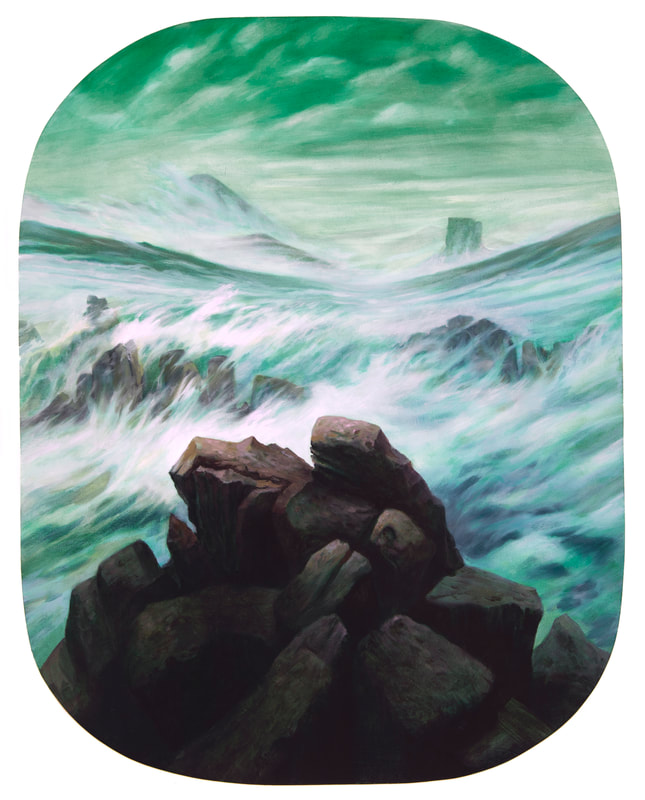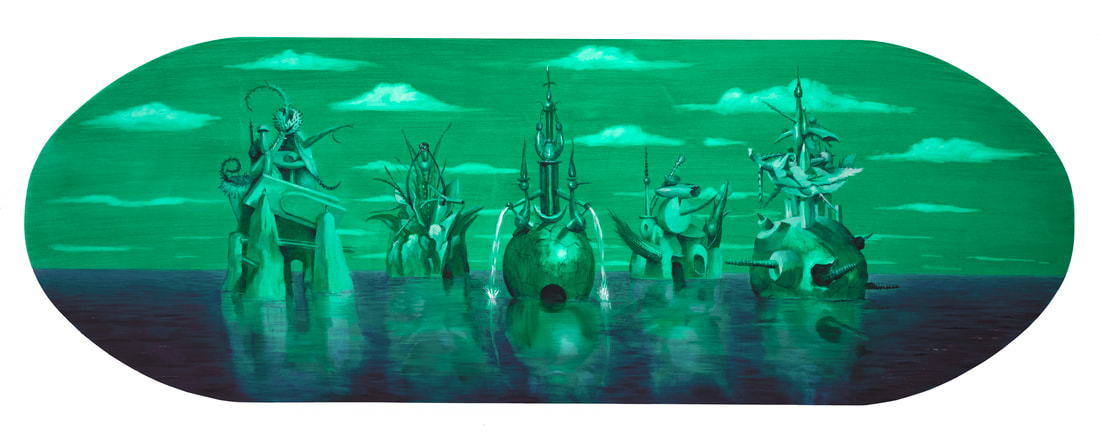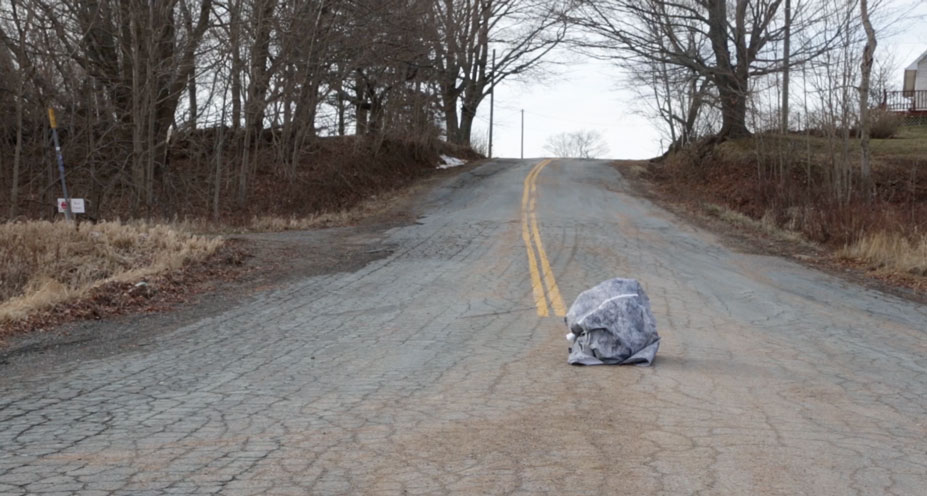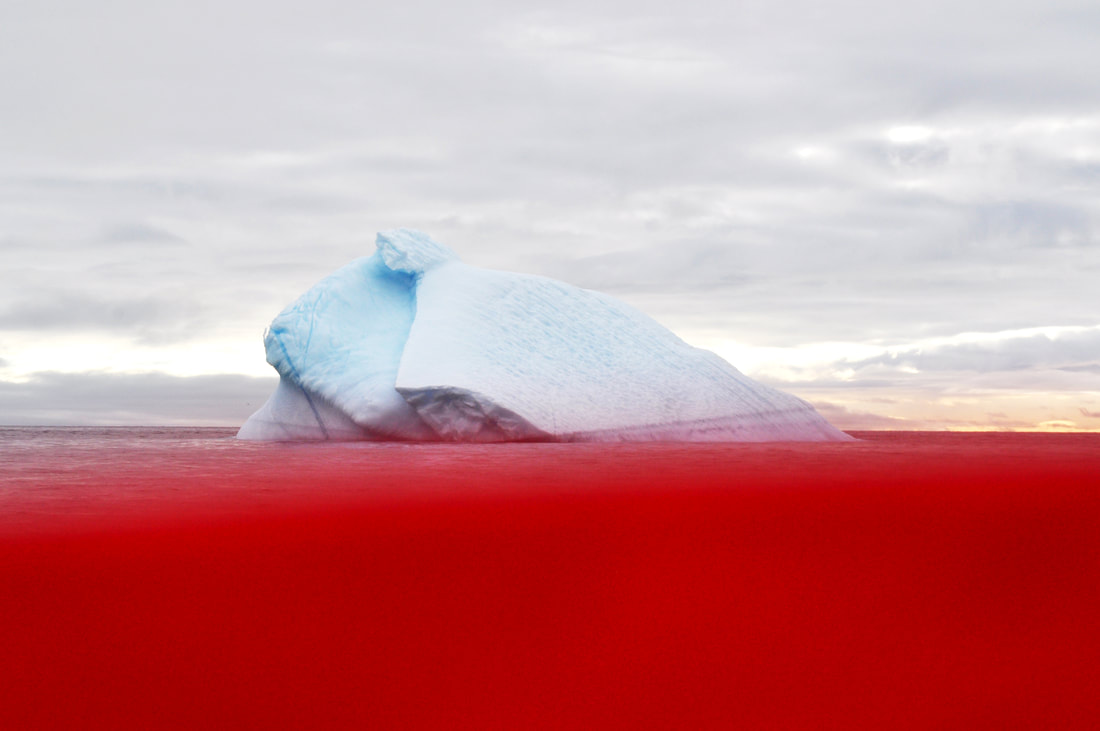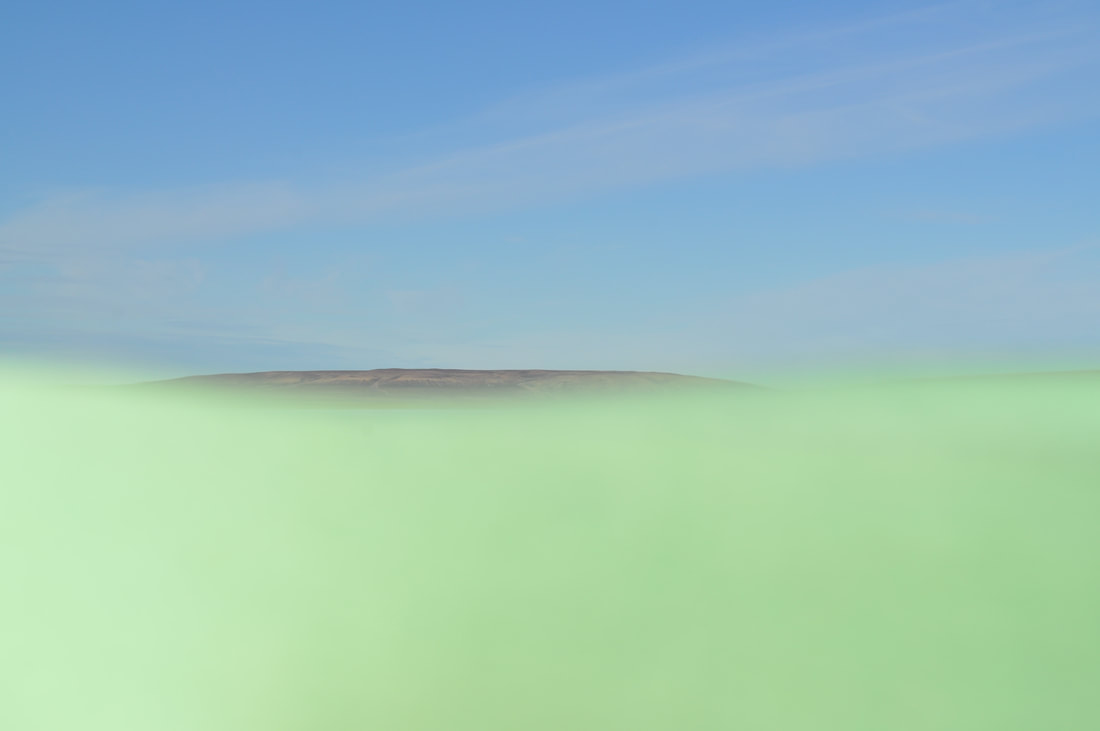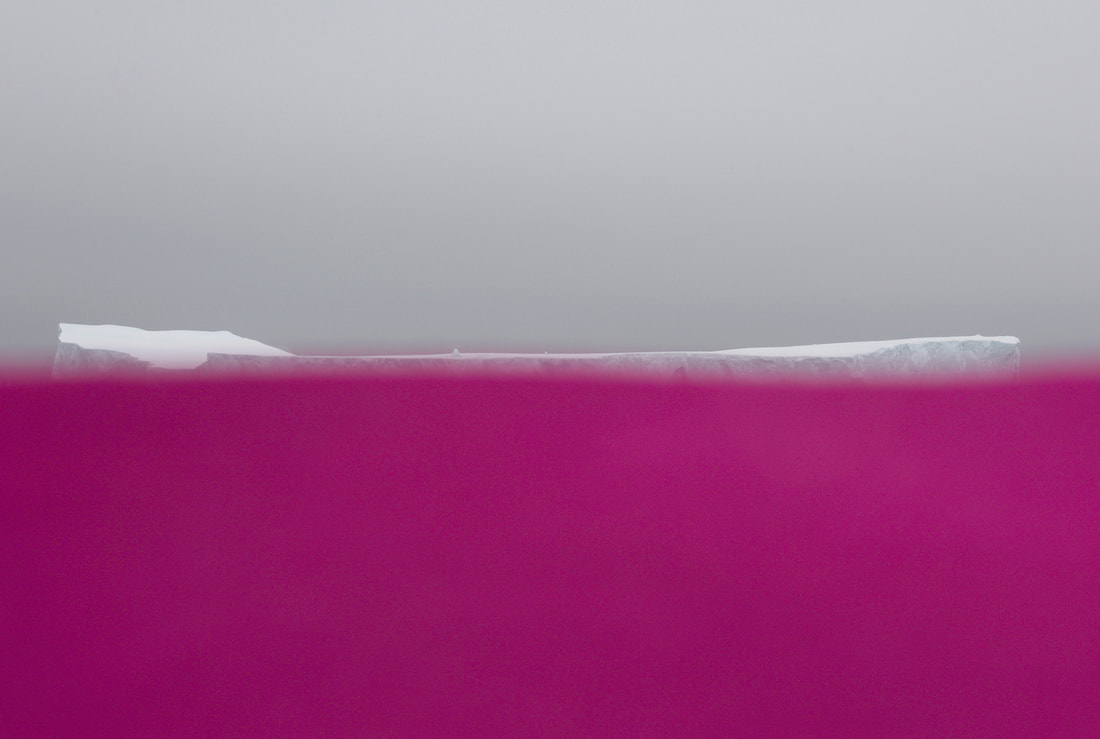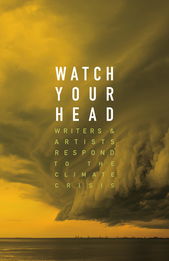|
1/31/2020 PAINTING: ADAM GUNNISLAND OF THE DEAD Rise of the Island of the Dead (2019) Oil on wood panel, 17 X 19 inches (irregular dimensions) After the photo Earth Rise (1968) taken by William Anders, crew of the Apollo 8 mission. Earth Rise is often attributed as being a photograph that contributed immensely to modern environmental awareness. It is predated by black and white photographs taken by an unmanned lunar orbiter two years prior, but it was the blue of the earth taken in Ander’s photo that resonated with millions of people. That brilliant blue contrasts with the dead grey of the lifeless moon and the stark black of the surrounding nothingness, emphasizing the jewel-like fragility of our own world. Island of the Dead (2019) Oil on wood panel, 23.5 X 23.5 inches (irregular dimensions) After the photo Blue Marble (1972) taken by the crew of the Apollo 17 mission. Rückenfigur (2019) Oil on wood panel, 34 X 27 inches (irregular dimensions) After Caspar David Friedrich’s Wanderer Above the Sea of Fog (1818). Friedrich’s painting is often used to represent the Romanticism movement and the sublime. Romanticism was in part a reaction to the industrial revolution marked by a nostalgia for an untouched natural world and a reverence for its overwhelming power. Ironically the spread and continuation of that industrialism is predicted to set in motion a new overpowering version of nature that does not include us. The original painting uses Rückenfigur; a compositional technique with a figure seen from behind contemplating a view before them. In this painting there is no figure; the future view of a dead world is instead seen from behind in time. Garden of Earthly Remains (2019) Oil on wood panel, 21 X 60 inches (irregular dimensions) After Hieronymus Bosch’s The Garden of Earthly Delights (1490 -1510). The five structures in this painting are based off the ones from the center panel of Bosch’s triptych painting. That painting suggests a moral warning about the consequences of a humanity let loose to act without boundaries. In my painting all the abundance of life and wild humanity from that center panel are gone with only the structures remaining. Island of the Dead - Artist Statement This work is focused on a scientific prediction of a change in the colour of the sky and oceans as a result of climate change. I came across this theory through the writings of Professor of Paleontology and Biology at Washington University, Peter Ward. He describes how in the past an increase in carbon dioxide has led to anoxic oceans where hydrogen sulfide producing bacteria altered the chemistry of the environment so that the oceans became purple and the sky became green. I first encountered this scientific prediction in Tim Flannery’s book about the urgent need for climate change action, Now or Never. He quotes Ward from his book Under a Green Sky where he describes a vision of a dead ocean and poisonous sky: Look out on the surface of the great sea itself, and as far as the eye can see there is a mirrored flatness, an ocean without whitecaps. Yet that is not the biggest surprise. From shore to the horizon, there is but an unending purple colour – a vast, flat oily purple, not looking at all like water. . . The colour comes from a vast concentration of purple bacteria. . . At last there is motion on the sea, yet it is not life, but antilife. Not far from the fetid shore, a large bubble of gas belches from the viscous oil slick-like surface. . . It is hydrogen sulphide, produced by green sulphur bacteria growing amid their purple cousins. There is one final surprise. We look upward, to the sky. High, vastly high overhead, there are thin clouds existing far in excess of the highest clouds found on our Earth. They exist in a place that changes the very colour of the sky itself. We are under a pale green sky, and it has the smell of death and poison. As a painter, this change in colour of the world’s landscapes captivated me. The blue of the sky and oceans seems to have always been and as if it always will be. This new colour pallet for the world will be sublime, strange and beautiful, but there will likely be no one around left to see it. Approaching climate change in painting through this change in colour is a phenomenological way to know an issue that is often hard for people to feel convinced of except as an abstract theory. I first came to this subject while working in Berlin last Winter and Spring. I spent a lot of time in Europe visiting museums and seeing historical paintings and contemplating my relationship to them and their relationship to today and came to specifically consider their associations to the environment and climate change. From that research I made a series of paintings referencing historical paintings and images, setting them in that future of purple oceans and green skies predicted by Ward. Adam Gunn is a painter whose work focuses on interests in ideas about natural and unnatural orders with a deep concern for how an image is brought into being. He was both formed and grown in Nova Scotia and currently dwells in Montreal. He has accumulated an MFA from Concordia University and a BFA from NSCAD University. He’s been semi-finalist in the RBC Canadian Painting Competition twice, and recently completed a 5-month residency in Berlin as part of the Nancy Petry Award.
1/18/2020 ART: JESSICA SLIPPBECOMING ROCK Becoming Rock (2018) Video excerpts from a series of 13 video performances (02:57) Becoming Rock: Road Rock (2019) Video still image from performance series ‘Becoming Rock’ Becoming Rock is a series of performative videos that explore the relationship between body and earth through the repeated action of becoming a rock within the landscape. Although it is physically impossible to merge with the land, Jessica Slipp sees the exposure of each repeated attempt as an absurd, awkward, yet genuine and honest gesture to engage with the land.
Jessica Slipp uses rocks as a form and means to compact earth and time. She is interested in what rocks contain and how, when deconstructed, they return to tiny particles of matter – the elemental component to the fabric of the universe and where all of life began. With concern for planet Earth, she looks to Donna Haraway’s rethinking of the Anthropocene and use of the term Chthulucene to describe our current epoch. This encourages the process of thinking, making, and being with all living and non-living species. In this time of ecological crisis and global climate change, it is vitally important to shift anthropocentric modes of thinking about the world to thinking with the world. Jessica Slipp is a Visual Artist currently living and working in the unceded Indigenous land of the Kanien’kehá:ka Nation in Tiohtiá:ke (Montréal). As an interdisciplinary artist her work investigates notions of place, uncovers new perspectives of land & landscape, and challenges the way we exist within the world. She is interested in the the ways that place and identity are embedded in the land through geological, ecological, and human histories, and the intrinsic connection we all share with the world — from the particles that randomly composed it, to the very nature that we embody. Through her artwork she attempts to repattern perspectives towards a more caring and compassionate engagement with the world, and seeks to find new ways of rekindling the fundamental relationship between body and earth. 1/8/2020 PHOTOGRAPHY: JESSICA HOUSTONHORIZON FELT Crossing The Line (2015) Archival Pigmented Print, 22 x 33 inches The Greening (2015) Archival Pigmented Print, 22 x 33 inches Ideas in Things (2018) Archival Pigmented Print, 22 x 33 inches The Horizon Felt photographs use color to create new cartographies of the polar regions. Using the horizon and colours from the landscape as points of reference, Jessica Houston placed different coloured felt in front of her lens while photographing the north and south poles. Abandoned outposts, remote scientific stations, and retreating glaciers speak to the life of places and the storied matter that shapes them. These photographs take stock of the embedded histories of the poles and their entanglement of colonialism, capitalism and environmental injustice, while opening up a space for rethinking the ‘natural’.
Jessica Houston travels from pole to pole—using objects, oral narratives, photography, and painting. Her collaborative projects include site-specific oral histories that amplify place as a living process and build knowledge across and human and more-than-human spectrum. She works on projects involving communities and their relationship to their environments in the Canadian Arctic, Antarctica, Greenland, Iceland, and Italy. Houston has created site-specific works for the New Jersey MOCA, Asbury Park, New Jersey; the Castello di Corigliano, Puglia, Italy; Governors Island, NY, NY; and The Albany Airport, Albany, NY. Her works are funded by The Canada Council for the Arts and are in the collections of Prêt d’oeuvres d’art, Musée National Des Beaux-Arts du Quebec;Bibliothèque et Archives nationales du Québec (BAnQ), Montréal, Québec; Bank of Montréal, Toronto; and the Consulate General of Monaco, Montréal. She has been invited to The Albers Foundation Residency, CAMAC Centre for Art, Science and Technology in France, and Skagaströnd in Iceland. |
|
ISSN 2563-0067 © Copyright 2023 | Watch Your Head Contributors Sign up for our Newsletter Buy our print anthology Watch Your Head: Writers & Artists Respond to the Climate Crisis (Coach House Books, 2020). |
